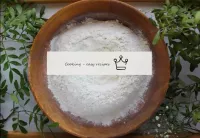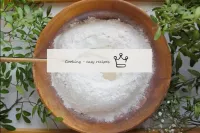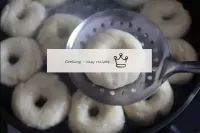Bagle with salmon
 8 servings
8 servings1 hour 45 min
Baigles are very similar to our bagels or dryers, only usually they are filled with all kinds of goodies and sprinkled with sesame, poppy or coarse salt on top when baking. They are perfect as a snack, will appeal to adults and children. You can make any filling on the beigl with salmon to your taste and desire. It will be very tasty to fill only with curd cheese and fish. Red caviar, all kinds of vegetables, fruits, jam, jam - all this can be used for filling. You are pleased with your appetite!
Wheat flour - 500 gr, Dry yeast - 7 gr, Sugar - 2.25 tbl, Salt - to taste, Water - 250 ml, Eggs - 1 pc., Vegetable oil - 2 tbl., Sesame - 2 tsp., Semga - 200 gr., Curd cheese - 2 tbl., Lettuce leaves - 50 gr., Onion - 0.5 pcs., Cucumbers - 0.5 pcs.
 I had a fresh semgi steak in my fridge. Before I started cooking, I salted the fish, seasoned it with ground peppers and sent it to the fridge. During the time while the baigles are being prepared, the fish will shine through and be ready to eat. For the recipe, you can take purchased chopped slightly salted or smoked semga.
I had a fresh semgi steak in my fridge. Before I started cooking, I salted the fish, seasoned it with ground peppers and sent it to the fridge. During the time while the baigles are being prepared, the fish will shine through and be ready to eat. For the recipe, you can take purchased chopped slightly salted or smoked semga.  Grease the deep bowl to the edges with vegetable or olive oil. Put dough in it, which is also greased with oil. Cover the cup with cling film and leave the dough to rise for an hour. It should increase in volume by 1. 5-2 times. Place the dough on a floured table and knead for a further 3-5 minutes. Divide the dough into balls of the same size.
Grease the deep bowl to the edges with vegetable or olive oil. Put dough in it, which is also greased with oil. Cover the cup with cling film and leave the dough to rise for an hour. It should increase in volume by 1. 5-2 times. Place the dough on a floured table and knead for a further 3-5 minutes. Divide the dough into balls of the same size.  Put a saucepan of water on the stove, bring to a boil and add sugar (based on 1 liter of water, 0. 5 tsp. sugar). Send the bagels to boiling water and cook on one side for about a minute, then another minute on the other side (make the flame slightly above average, the water should not gurgle much).
Put a saucepan of water on the stove, bring to a boil and add sugar (based on 1 liter of water, 0. 5 tsp. sugar). Send the bagels to boiling water and cook on one side for about a minute, then another minute on the other side (make the flame slightly above average, the water should not gurgle much).  Send to a preheated oven for 20-25 minutes at 180-200 degrees. The time and temperature may differ from what is indicated in the recipe, depending on your oven and its capabilities. If you are cooking bagels for the first time, then do not go far from the oven and periodically look at the pastry so that it does not burn.
Send to a preheated oven for 20-25 minutes at 180-200 degrees. The time and temperature may differ from what is indicated in the recipe, depending on your oven and its capabilities. If you are cooking bagels for the first time, then do not go far from the oven and periodically look at the pastry so that it does not burn. The liquid in which yeast is diluted should be pleasant to the touch, no higher than 40 degrees. Why is this important? In a warm environment, yeast is well activated, in a hot environment it will die, and in a cold environment it simply will not work. To avoid unpleasant surprises, check the yeast before mixing with the rest of the ingredients. Pour some warm milk into a bowl, stir yeast in it. Cover the bowl with a tea towel and place in a warm place without drafts for 10-15 minutes. During this time, a foam yeast cap should appear on the surface of the opara. If this did not happen, then the fermentation process did not begin (yeast is expired or spoiled). In this case, it is worth taking other yeast, otherwise baking will not work.
Be prepared for the fact that flour may be needed more or less than indicated in the recipe. Focus not on the amount of flour, but on the desired consistency of the dough. To avoid mistakes, read about flour and its properties!
Keep in mind that everyone has different ovens. The temperature and cooking time may differ from those indicated in the recipe. To make any baked dish successful, use useful information about the features of the ovens!
 Español
Español Français
Français Português
Português Русский
Русский 简体中文
简体中文 繁體中文
繁體中文 日本語
日本語 한국어
한국어 العربية
العربية Türkçe
Türkçe Қазақ
Қазақ Deutsch
Deutsch Italiano
Italiano Українська
Українська
 How to make baigles with sumga? Prepare all the products that are listed.
How to make baigles with sumga? Prepare all the products that are listed.  Stir dry yeast with warm water (about 50 ml) in a deep plate.
Stir dry yeast with warm water (about 50 ml) in a deep plate.  Add 2 tbsp. sifted flour and 2 tbsp. sugar. Mix everything well, cover with cling film and leave for 15 minutes.
Add 2 tbsp. sifted flour and 2 tbsp. sugar. Mix everything well, cover with cling film and leave for 15 minutes.  Sift the flour into a large, deep cup or bowl, add the salt, mix. Make a small indentation in the centre of the flour.
Sift the flour into a large, deep cup or bowl, add the salt, mix. Make a small indentation in the centre of the flour.  Pour in the yeast and start gently kneading the dough with a fork.
Pour in the yeast and start gently kneading the dough with a fork.  Add 200 ml gradually. Water and mix the dough.
Add 200 ml gradually. Water and mix the dough.  If the dough turned out to be liquid, then add a little more flour. Stir the dough for 5-7 minutes. It should be elastic and not stick to the hands.
If the dough turned out to be liquid, then add a little more flour. Stir the dough for 5-7 minutes. It should be elastic and not stick to the hands.  If you want to get large bagels, then make 8-10 balls. I got 17 pieces and bagels turned out to be the size of a child's fist. In each balloon, make a hole in the middle with your fingers. Form bagels.
If you want to get large bagels, then make 8-10 balls. I got 17 pieces and bagels turned out to be the size of a child's fist. In each balloon, make a hole in the middle with your fingers. Form bagels.  Place the stock on a flat surface, sprinkled with flour and cover the bagels with clingfilm or a light tea towel. Leave for 20-30 minutes.
Place the stock on a flat surface, sprinkled with flour and cover the bagels with clingfilm or a light tea towel. Leave for 20-30 minutes.  Use a slotted spoon to remove the baigles from the water.
Use a slotted spoon to remove the baigles from the water.  Line a baking sheet with baking paper and lay out the bagels a short distance apart. Brush them with a silicone tassel with a beaten egg.
Line a baking sheet with baking paper and lay out the bagels a short distance apart. Brush them with a silicone tassel with a beaten egg.  Sprinkle with sesame seeds (poppy or coarse salt).
Sprinkle with sesame seeds (poppy or coarse salt).  Remove the ready-made ruddy baigles from the oven and cool slightly.
Remove the ready-made ruddy baigles from the oven and cool slightly.  Or leave until completely cooled.
Or leave until completely cooled.  Prepare all products for filling.
Prepare all products for filling.  Cut the fish into thin pieces, onions in half rings, cucumbers in thin circles. Rinse and dry the lettuce sheets.
Cut the fish into thin pieces, onions in half rings, cucumbers in thin circles. Rinse and dry the lettuce sheets.  Halve the bagle. Spread with cream cheese.
Halve the bagle. Spread with cream cheese.  Lay out lettuce leaflets and fish.
Lay out lettuce leaflets and fish.  Next, add the onion and cucumber.
Next, add the onion and cucumber.  Cover the top with the second half of a bun greased with cream cheese. Done!
Cover the top with the second half of a bun greased with cream cheese. Done!